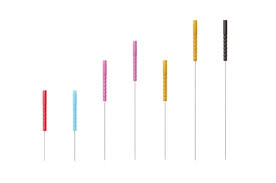Japanese Needle sizes
Why does Japanese acupuncture seem more comfortable to receive than other acupuncture's?
Lawrence
5/6/20242 min read


Many patients are surprised at how painless the whole Japanese acupuncture treatment seems compared with other acupuncture they have had before. One of the reasons is that Japanese acupuncture styles in general use much finer needles than other styles. For example, I use a #1 needle for most points, which is 0.16” in diameter and a #02 needle for sensitive points which is 0.12” in diameter. Most Chinese styles use 0.20” to 0.35”, so their needles are much thicker and hence can be less comfortable. Also, Chinese acupuncture styles tend to manipulate the needle much more and use deeper insertions than Japanese styles and also have a technique called ‘de-qi’ (finding the qi), which can be quite uncomfortable, (more about why ‘de-qi’ is unnecessary in a later blog posting).
An acupuncture needle is not really a needle or hollow tube, but a piece of highly polished and sharpened stainless steel wire. As fine acupuncture needles are only slightly thicker than a human hair, over 40 acupuncture needles can fit in the hole of a standard hypodermic (hollow) needle. Hence having an injection is far more uncomfortable than having an almost painless fine acupuncture needle inserted.
Also, most acupuncturists use a guide tube to insert and position the needle, which reduces the pain on insertion. Guide tubes have smooth, rounded edges, which provide a more comfortable experience for patients during acupuncture treatments. A skilled acupuncturist can use the guide tube to comfortably move anatomical structures out of the way for more precise needling. This enables practitioners to access specific acupuncture points with greater accuracy, enhancing the effectiveness of the treatment. Surprisingly, the guide tube was invented in the 1600’s by a blind Japanese acupuncturist called Waichi Sugiyama.
He went blind when young from smallpox. He then went on to become an acupuncturist, as that was one of the few jobs that were available for the blind in Japan at that time (and even recently, as Kiiko Matsumoto’s teacher, Master Nagano, was also blind). The story is that when Waichi was out walking, he tripped on a stone and fell. A pine needle sheathed in a bamboo reed ended up piercing the skin of his leg almost painlessly. Having realised that the pine needle was guided deep into the skin by the bamboo sheath, he then invented and used a small tube to guide his needles and this ‘guide tube’ was of course a very great help for all the blind acupuncturists at the time and for most acupuncturists today!
Get in touch
Address
Stroud Acupuncture
The Rosery
Highfield Road
Whiteshill
Stroud
GL6 6AL
